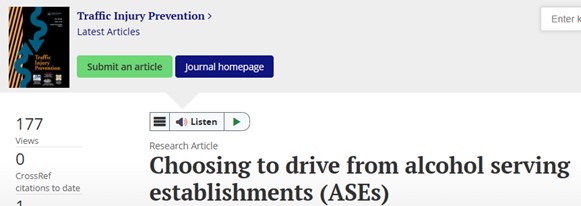Amin Shaer, Andrés Fielbaum &David Levinson
Abstract
Objective
The prevalence of Driving Under the Influence (DUI) of alcohol or drugs has become a prominent factor in the occurrence of severe road crashes worldwide. Driving often occurs after visiting, and presumably drinking, at Alcohol-Serving Establishments (ASEs), and is thus of interest as a possible source of DUI events.
Methods
We apply statistical and machine learning models to the Victorian Integrated Survey of Travel and Activity (VISTA) to identify factors that contribute to driving in trips from ASEs in Australia’s state of Victoria.
Results
Our results highlight that approximately 10% of individuals who traveled to ASEs as car passengers switched to driving after leaving there. It was also observed that travel distance shorter than 1 km and activity duration between 3 and 4 h positively impacts the mode switching from car driver to other modes in ASEs trips. Further findings illustrate a decline in driving after midnight, with an increase in the use of public transport and taxis. Individuals prefer driving for long-distance ASEs trips and walking for short distances. Going home also increased the likelihood of driving, whereas engaging in other social activities did not. Longer stays at ASEs and leaving vehicles overnight reduce the propensity to drive, likely due to increased alcohol consumption during these times.
Conclusions
These findings suggest behavioral adjustments that can mitigate driving under the influence. Specifically, people may walk for short-distance trips and use public transport or taxis for longer ASEs trips.
